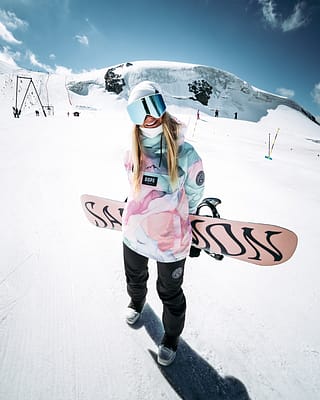What size snowboard do I need? Snowboard size chart
In this instalment of our tech tips series, we are talking snowboard size! Size matters, especially when choosing the right size snowboard for your level and the type of terrain you like to ride.

Our snowboarding tech tips series will help guide you through each step of your purchasing decision and the first time on your new board. We talk about choosing the right equipment for your style of riding, setting up your snowboard and maintaining your gear. This series will be short but sweet, so you can find all information needed within a few lines.
Let's start with one of the most important questions that you will stumble across when buying a snowboard: what size do I need?
This might also be interesting for intermediate snowboarders who are looking to buy their 2nd or 3rd snowboard and are still not sure if they are riding the right size of equipment or if they are ready to downsize an inch or two. And off we go!

Enhance your snowboarding experience with the right gear!
Having the right snowboard is merely the first step towards enjoying an optimal mountain adventure. It's equally important to don the appropriate attire to keep you warm, comfortable, and stylish on the slopes. Kickstart your journey with our curated selections of outerwear. If you're searching for the perfect blend of functionality and style, explore our vast range of men’s snowboard jackets and women's snowboard jackets. Let our collections help you step up your snowboarding game!
How to find the right snowboard size
Body weight to choose the right size
To find the right snowboard size for you, firstly it is important to go by your body’s weight more than your body’s height. The second factor that can influence the choice of length when buying a snowboard is in which terrain you mainly want to use your new board. The length of park boards, all mountain snowboards and power boards should not be the same because the right snowboard length will make riding the different terrains easier and more enjoyable.
Therefore, we made a little graph to easily find the perfectly sized snowboard for you. Just follow the line with your weight and see which snowboards sizing we suggest for you.
Snowboard size chart
| Weight | Snowboard Size |
| 50 - 55 kg | 128 – 136 cm |
| 55 - 60 kg | 136 – 145 cm |
| 60 - 65 kg | 143 – 152 cm |
| 65 - 70 kg | 149 – 157 cm |
| 70 - 75 kg | 154 – 163 cm |
| 75 - 80 kg | 160 – 167 cm |
| > 80 kg | > 160 cm |

Snowboard size and style of riding
Now let’s look at the second factor that has an influence on your perfect size: the riding style. Where do you want to mainly use the snowboard you are looking to buy? If you found the perfect snowboard length next to your weight, you still have quite a big range of snowboards size that you can choose from.
For our example, we will have a look at the perfect size for someone with a body weight of 70 kg. The example can be applied to any other weight and board length on the graph. We will look at the perfect snowboard length of a beginner’s board, an all mountain board, a park board and a powder board.
Talking about a person with 70 kg, the range for our perfect snowboard lies between 154 cm and 163 cm. So let’s check in which part of the size chart range you should buy your new snowboard considering the different riding style.
| Snowboard size | Riding style |
| 154 – 158 cm | Park board For a park board, you should go for a snowboard length at the lower part of the size range. The shorter the board, the easier it will be to turn & rotate in the park. For hitting big jumps or attacking the pipe you will want a little longer board for extra stability. |
| 156 – 160 cm | All mountain board If you want to be able to do a bit of everything with just one board, a snowboard in the middle of the range will do the job. Beginner board This size range is also perfect for a rider, who is looking for their first snowboard. It should not be too long, to make your first turns easy and not too short to still make you feel safe and stable while riding. |
| > 160 cm | Powder board Your powder board should be at the longer end of the scale for extra floatiness when riding powder. |

What else should I consider?
A few other things to consider and keep in the back of your mind as you progress (as you expect your equipment to become more advanced as you refine your skills).
Board shapes
Snowboards have lots of different shapes depending on the type, but there are some constants across all boards. They will all have a nose and tail, and they’ll all have contact points and a waist. The contact points are the widest points of the board — usually outside the bindings, just before the board curves up for the nose and tail (in true/directional twin boards, but that’s an explanation for a different guide).
The ‘waist’ is the narrowest part in between the bindings. Snowboards will have what’s known as a ‘side cut’, which refers to the concave curve between the contact points. Side cut works inherently with stiffness to produce stability and edge hold while the board flexes under pressure. Deeper side cuts with a smaller radius (more substantial curve) are often termed as ‘aggressive’ and are great for faster riding. Less aggressive sidecuts offer more stability at low speed, but are usually less stable at high speeds.
Snowboard width
The ‘correct’ snowboard width is the one that feels the best. But generally, snowboards are made with a target overhang in mind. Overhang refers to the amount of your boots and bindings that poke out over the edges of your board. Snowboard boots are often two centimetres bigger than your boot at the toe and heel. How big a boot actually is, highly depends on the brand.
The difficulty of this is compounded by your binding angles. Someone who rides +3/-3 will have more overhang than someone who rides +15/-15 on the same board, with the same size boots. As your angles increase, the boots turn outwards, reducing their ‘length’ across the board. And this is made even trickier by some bindings being pretty big, too.
It’s just good to bear in mind that larger boots and big bindings may require a wider width board to eliminate that extra heel and toe drag. As a rule of thumb, a 2cm overhang front and back should be your maximum, and a 0.5 overhang should be your minimum. That 1-1.5cm overhang is usually the sweet spot. But it’s all down to preference!
Flex
Snowboard flex is another concept to think about when buying. The flex simply refers to how flexible the board is, is it soft and buttery for park antics or rigid and robust for carving up a storm.Then if you really want to dig deep into the nuances of what makes the right sized snowboard, you can also explore a sintered snowboard base vs extruded base or maybe how the snowboard hole patterns are compatible with a particular type of binding.For the moment, don’t worry, as long as your snowboard is a dream to ride, that’s all that matters.

To sum it up: snowboard sizing and types
- Choose your park board at the lower end of the size scale for extra maneuverability
- If you are a beginner or are looking for an all mountain board, go for a snowboard in the middle of the size range for stability and easy turning
- Choose your powder board at the longer end of the size scale for a floaty powder experience
We hope this was helpful for all those riders who are struggling to find the perfect snowboard sizing for their skill level and for their style of riding. Now, that you found your perfect board, it is time to set up your snowboard! In the next tech tip we will talk goofy vs. regular, bindings and binding angles. So stay tuned for next week’s snowboard tech tip and stay stoked!
Looking for the latest snowboard clothing styles? Check these out…
What are the four main snowboard types?
Mens snowboard pants / Womens snowboard pants
Snowboarding tips for beginners guide
